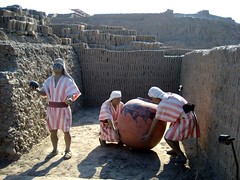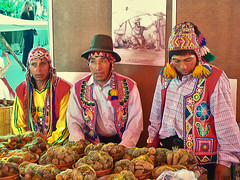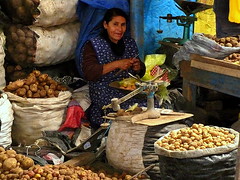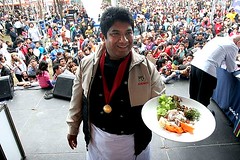Andrew Kolasinski introduces us to Tacu Tacu, a delicious dish with humble origins.
Category: "La Libertad & Trujillo Guide"
Gastro-tourism in Pacasmayo and Lizard Cebiche!
Lizard cebiches and pot-baked ducks are just two local dishes waiting to surprise you and your taste buds. Welcome to the world of Jequetepeque, San Pedro de Lloc and Pacasmayo cuisine!
Volunteer at ancient Chan Chan
Does toiling under the hot desert sun heaving bricks up a ladder to rebuild collapsing walls interest you? What if the walls were many hundreds and hundreds of years old and part of the world’s largest adobe city, one of the largest cities of any kind in the ancient world? A city home to the rulers of the Peruvian desert coast, the Chimú imperial heart of Chan Chan. Does a couple of days of hands-on archaeology at one of the world’s most important archaeological sites interest YOU?
El Brujo Archaeological Complex
Brujo was one of the most important religious sites of the Moche culture. One of the pyramidal structures found there has beautiful preserved high relief murals, still with original paint – making it one of the most important archaeological sites too.
Huaca Arco Iris
One of the most interesting and often-visited Chimú constructions other than the city of Chan Chan is the Huaca Arco Iris, the rainbow pyramid, otherwise known and the dragon pyramid. This Chimú temple gets these names from the decoration the covers all of it walls
Chan Chan
It was the largest city that had existed in South America and remained that way even when it lay in ruins during part of the Spanish colonial period. At 18km2 by some measurements and more than 20km2 including its surrounding agricultural districts, this gigantic city formed the capital of the Chimor kingdom of the Chimú civilisation.
The Chimú and the Kingdom of Chimor
In the aftermath of the collapse of the the Moche civilisation in the late 700s A.D. a new civilisation was born. In the late 800s until the early 1000s the Chimú culture began to establish itself, reaching it’s peak in the 1200s and lasting until the 1490s when they were conquered by the Incas.
Huanchaco and the Caballitos de Totora
Huanchaco is a friendly beach town popular during the summer months with the people of Trujillo and known as a excellent surf spot. It is also a popular spot to eat ceviche.
Museo Arqueológico Cassinelli
What do you do if you own a successful gas station on the road out of town? Build your own collection of ancient artefacts, of course! For over 40 years Señor José Cassinelli (sometimes incorrectly written as Casinelli) has been buying ceramics and other items from the illicit black market of huaqueros or tomb robbers.
Moche: Huaca del Sol y Huaca de la Luna
In the heart of their world, the Moche constructed two truncated pyramids, the gigantic pyramid of the Sun (sol) and the smaller pyramid of the Moon (luna). These pyramids, and the city that spanned between them functioned as their capital.
The Huaca del Sol is by far the largest of the two and is one of two pyramids in Peru thought to possibly be the largest adobe mud-brick construction in the Americas.
The Moche
The Moche (or Mochica) were a civilisation who occupied the northern Peruvian coast between modern-day Lambayeque and Virú and influenced an area that ranged from Huarmey to Piura in the north. They were a collection of peoples with a similar culture and had no central political authority on a grand scale, i.e. they never formed an empire. Primarily farmers and fishers they built irrigation systems to create fertile areas in the desert and created rafts known as the Caballitos de Totora to fish from. But by far their most important legacy was one of art.
Sopa Teóloga
Theologic Soup is the name for a soup created in the 1600s by Dominican monks in Northern Peru, particularly Trujillo. It is made of white bread, potato, tomato, sliced cheese and milk. It can have chicken or turkey meat, sometimes both. The seasoning is the blending of garlic, leek, celery, oregan, pepper, salt, oregan, white onion, laurel and yellow chilli pepper.










![When the U.S. sneezes, Peru drinks tea. [Featured]](http://farm4.static.flickr.com/3192/2959833537_af77ed5003_m.jpg)